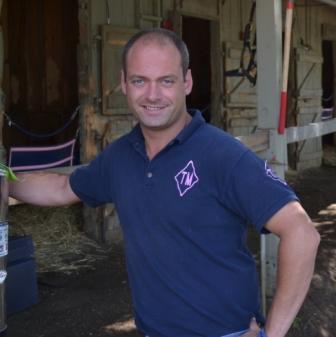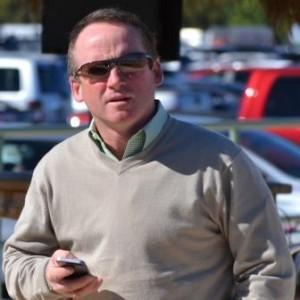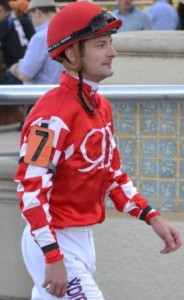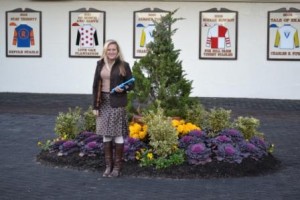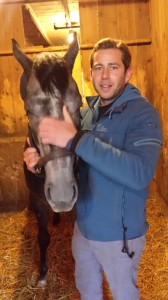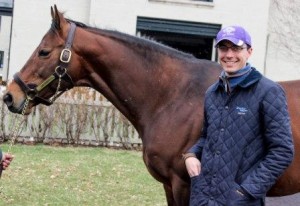Meet George Adams – Bloodstock Agent
Neal wanted this site to try and help new fans, experienced handicappers, and anyone who wants to learn about the game have access to all the different people who work in the industry. For me, I have often wondered exactly what is a “bloodstock agent”? Thankfully, I’ve gotten to know a young and up and coming bloodstock agent, George Adams, who operates Housatonic Bloodstock LLC, in Baltimore, Maryland. Reading his answers you’ll see he has passion for his work. George agreed to answer my questions about how he got into the business, what he does as a bloodstock agent, and the challenges and possibilities facing the greatest game played outdoors. At the end of the article you’ll find a brief biography supplied by George.

Tell me what is your history with horses? I rode horses as a child, because I was interested in horse racing but didn’t live near a track. So I took some riding lessons at a local stable, did some showing and earned a couple of ribbons, but when the lessons turned to jumping, I stopped because that wasn’t something I was interested in, it was just the racing. Later on, I worked as a hot walker for Shug McGaughey at Belmont and Saratoga for a summer during college, and at Claiborne Farm in Kentucky while I took a year off between college and law school. At Claiborne I prepped sales yearlings, worked a Keeneland September Sale, and then groomed stallions for a bit during the off-season, including Danzig and Devil’s Bag after they were retired from stud duty. Then after I had become a lawyer and practiced for a few years, I left the law and got back into racing and breeding about 8 or 9 years ago now.
Did you grow up around horses? I did not. I grew up in Western Massachusetts, a little less than 90 minutes from Saratoga, and my family started going there a couple times a summer once I got interested in racing. We’d make a whole day out of it with blankets and picnics on the lawn in the back. But other than the riding lessons I mentioned above, I wasn’t around horses and had no connection to them absent those I eventually made for myself.
If not, how did you first get introduced to horses? Nobody is really certain — the best we can figure is that I read the Black Stallion books at around 10 years old, and for some reason that just really piqued my interest. I started watching whatever racing I could that was on TV (mostly just the Triple Crown and Breeders’ Cup), I subscribed to the Blood-Horse and the Thoroughbred Times, and there were a couple of local convenience stores that sold the DRF so I’d get those on the weekends and read all the articles.
Did you have a direct path to bloodstock work? I would not say that at all. With no connection to racing, my path was pretty unorthodox, I think. Once I was ready to leave the legal field and get (back) into racing as a career, it actually took some time and a ton of networking to even find a toe-hold, as I wasn’t born into a racing family and was coming to it a little later in life where I couldn’t necessarily commit to a 7-days a week hot walking or grooming job for minimal pay, something like that. And I was pretty sure that my interest lay more on the breeding/farm side of things than at the track, anyway.
I’ve heard many comments that the industry naturally nurtures those who grow up in the sport or industry, but aren’t as supportive of those who try to break in cold. Maryland has a summer intern program to try to support those who show interest, can you think of ways the industry can support recruitment of people who have an interest but no background, based on your experiences? I’ve heard that also, but it wasn’t my own personal experience. Folks were very supportive when I was trying to find a toe-hold in the industry, it was just that because of how I was coming into it a little later in life, there wasn’t as clear of a path. Not like when you grow up in the barn afternoons and weekends and have constantly built your knowledge and experience base. But I would certainly not say that people were unsupportive with respect to my efforts, there just was no clear, good answer for what position would suit me. As far as new ways to support recruitment, I think Maryland’s summer internship program is great, and there are a couple of colleges with programs dedicated to students with an interest in the racing industry. Beyond that, I think tracks and farms just need to do more community outreach, maybe, to let people know what kinds of jobs are available. The biggest hurdles, obviously, are the fact that caring for horses does require a certain amount of skill (though it’s teachable), but at the same time the hours are very long just by the nature of the fact that horses need care 7 days a week, and the pay is maybe not the greatest. I’m not entirely sure how to overcome some of those issues, because as an owner, it already feels like day rates are very high, and you have to win a lot of races just to break even.
Actually what is the definition of bloodstock work? I feel as if there are different elements or divisions to bloodstock work. If so how are they broken down? A bloodstock agent is basically someone that buys and sells horses for clients, and in many cases also encompasses advising on breeding decisions as well. Some bloodstock agents work exclusively with racehorses and/or yearlings, some focus more on broodmares and stallion selection and the pedigree aspects of that. But they’d all fall under the umbrella of “bloodstock”, which is historically a term for Thoroughbreds generally.
So how does one learn to perform pedigree analysis? I don’t know that I can speak to this question generally, but in my own case it was all down to years of reading and research. I was always the most interested in the pedigree aspect of the industry, and the history of families and sire-lines. There are plenty of research-style books out there on those types of topics, and even if the specific horses discussed become dated relatively quickly, the theories hold up over time. I also, as a kid, used to sit and read every Keeneland catalog and every Stallion Register cover to cover when they arrived, plus the pedigree write-ups in the Blood-Horse and Thoroughbred Times issues. So over time I just assimilated all of that information in my head, and developed my own beliefs on how best to put it into actual practice.
Do you start out with ideal matings and with a budget in mind? Typically the starting point is the client’s budget and geographic restrictions. There’s no sense in putting a name like Tapit into the client’s head at the outset if they’re on a four-figure budget and want to breed to a Maryland stallion. So my first question is always “What’s your budget for a stud fee?”, and the second one is “What is your plan with the resulting foal?” Then that guides the recommendations that will eventually be made for stallions depending on the specific mare’s family.
How far in advance should someone work with a pedigree analyst to create mating reports? Well, as early as possible so that the analyst can take their time and not rush or miss anything. Though having said that, a mating report in July might not be overly helpful as plenty can change between July and February, either in the mare’s family, or in which stallions are available at what stud fees.
Are decisions for matings based on commercial or market considerations versus racing considerations? In my experience, even when clients say they plan to breed to race, they always want to hedge by having something that they might be able to sell as a foal or a yearling. So the commercial side often drives the bus, even though at the end of the day the goal is still to breed a good race horse.
How do pedigree analysts receive compensation? A pedigree analyst would typically charge a flat fee for the analysis. Not to be confused with bloodstock agents, who usually work on a commission-based structure where they receive a percentage of a purchase or sale price as their compensation.
What do you see are the three things that concern you about the industry’s future? I am concerned about (1) the ever-decreasing number of starts made by the average racehorse, and (2) the ever-increasing number of horses trained by a smaller and smaller pool of trainers. And more generally, (3) the short-sightedness of people looking out for their own immediate best interests instead of being able to take a longer-term, more holistic view of the racing and breeding industry.
Reviewing your 3 problems, do you have suggestions how the industry can solve any of them? Well, I think the first two issues are inter-connected to a large degree. If you could somehow limit trainers to a certain number of horses in training, that would spread the horse population around a bit more, and then that might help horses run more often because the way it is now the big trainers can only run so many horses in each race. So if a trainer has 4 horses that all fit a condition, they can’t run all 4 of those in the same race, but if the 4 horses were spread among 2 or 3 different trainers, they could all run in the same spot. It would help employ more trainers and fill more races. But having said that, I’m not sure how you could implement a limit like that, either practically or legally As far as the problem of short-sightedness, that’s not unique to the racing industry, it’s human nature. Or seems to be nowadays, anyway — people worry that if someone else is getting a bigger piece of the pie, it must mean that they’re getting a smaller one, instead of realizing that you can make the pie bigger and then it’s better for everyone. But I think the Jockey Club’s 140-mare cap for stallions is a good start — of course it’s being challenged in court, which is totally to be expected. But to me, if you have a popular stallion who is going to reach the cap, you can just increase his stud fee — supply and demand. And if you get shut out of a stallion, there will be plenty more options out there, and the cap will allow more stallions to have that many more chances to prove that they deserve the extra mares. I think it’s far preferable to give more stallions more of a shot, than to allow the industry to breed itself into a corner in the interests of making as much money as possible right now.
What do you see are the three things that give you hope for the future? Racing has been around a long, long time now, with relatively minor changes to the way things work in the grand scheme of things — that gives me hope that the industry and its participants are entrenched and resilient and will be able to weather things like negative public perception and controversies that make their way to the mainstream media. I am also excited by the number of young, passionate, motivated industry participants — we always hear about how racing is an old person’s sport, but there is a really vibrant younger generation out there that gives me hope for the future.
George Adam’s bio: After a short career as a corporate attorney, George decided to follow his passion and embarked on a career in the Thoroughbred industry in 2012. He established his Housatonic Bloodstock LLC in 2014, which provides pedigree analysis and mating recommendations to clients, as well as assistance identifying and inspecting potential purchases both privately and at auction. He also serves as the Director of Stallions and Breeding for Wasabi Ventures Stables. His prior industry experience includes stints with Claiborne Farm, Country Life Farm, and Shug McGaughey.

